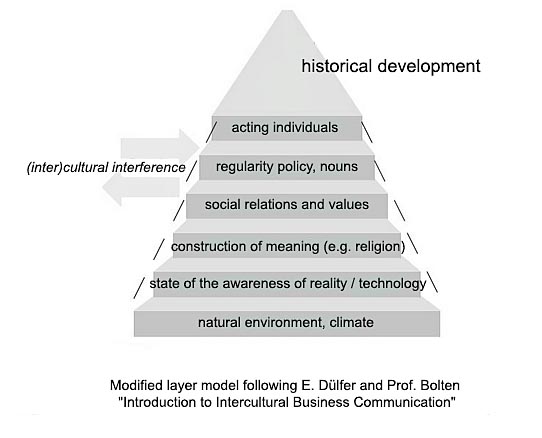As with an iceberg, only the small, external part of a culture can be seen on the surface whereby many areas lie hidden in the depths. But those parts have a great influence on the visible areas of the culture.
Connections between the perceptible (Perceptas) and the hidden (Conceptas) can be explained with the help of an iceberg, of which the largest part lies in the depths. A layer model by Dülfer, derived from the iceberg model, is intended to illustrate the „lifeworld ties of entrepreneurial action“.
„Perceptas“ offer the possibility to describe cultural characteristics, „Conceptas“ – to explain them. Artifacts such as office buildings, dress codes, logos, for example, represent directly visible „signs“ of a corporate culture; however, only a selection is ever recorded at this level of perception („Perceptas“). For example, high-quality, ergonomic computer chairs for the employees (i.e. perceptible artefacts) of a company can be a „sign“ that the company cares about the health of its employees.
In another company, however, this sign could also conceal the fact that the company has these chairs in the office mainly for reasons of prestige – to document to the outside world that it is doing well economically. In neither case, however, it is possible to make a hundred percent statement about the motivation / corporate culture as long as one does not know the values, thoughts, basic assumptions, i.e. the (imperceptible) concepts of action – „Conceptas“.
Iceberg Model
The iceberg model, which later emerged from this, accordingly ascribes only the tip of the iceberg to the perceptible, the „Perceptas“, while the actual „mountain massif“, the „Conceptas“, remains hidden under the water: Thus, a culture can only be explained and understood by including these conceptual backgrounds. „Just as the ‚what‘ of a culture is described at the level of the ‚Perceptas‘, the ‚Conceptas‘ level enables explanations of the ‚why‘ of certain characteristics and functional contexts of a culture in a second step. In this way, historical perspectives ultimately also always come into play, which in turn offer possibilities for linkage and, in a third step, allow cultures to be understood as open networks of – both in the present and in the past – infinitely many interrelated actions.
Layer model
Eberhard Dülfer’s „layered model of environmental consideration“ is often used to explain the lifeworld ties of entrepreneurial action (Dülfer 1999). The culture-bound model consists of several interrelated layers (following the iceberg model) that influence the behavior of managers.
Although the model has some weaknesses in detail, such as structure- instead of process-oriented presentation and neglect of intercultural and historical influencing factors, it also impressively documents the interdependence of the individual cultural „levels“

